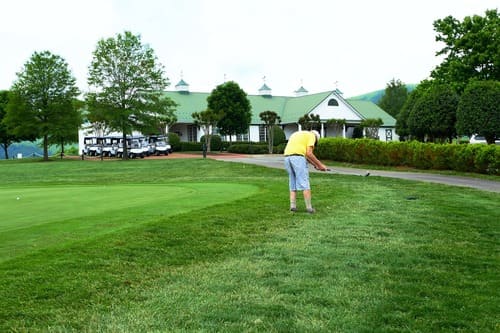Picture this: you’ve nailed an incredible tee shot, and your second stroke has left you tantalizingly close to the green. Now, it’s time for that crucial chip shot that could make or break your chances of scoring par or even a birdie. But here’s the catch—going for a traditional chip comes with its fair share of risks. A slight miscalculation, and your ball could roll right through the green, leaving you frustrated. So, what’s the alternative? Enter the Texas wedge, a secret weapon in the golfer’s arsenal that’s equal parts fun and effective.
Unraveling the Mystery of the Texas Wedge
The name might throw you off, but the Texas wedge has nothing to do with wedges. In fact, it’s all about the putter! Imagine using your trusty putter to strike the ball when you find yourself off the green. That’s what the Texas wedge is all about. It’s like giving your putter a chance to shine in a whole new way.
Why go for a putt instead of a chip, you might wonder? Well, the key lies in keeping the ball close to the ground and minimizing its momentum. As golf legend Arnold Palmer once said, “Your worst putt will usually be as good as your best chip.” So, if you struggle with pitching wedges or generating backspin, this unique technique could be your ticket to success.
Using your putter reduces the risk of overshooting the green. Of course, you’ll still need to gauge the power and consider the lie, but this technique offers a precise approach—especially on fast greens, in windy conditions, or when your chip shot lacks confidence. Even the best wedge players worldwide have embraced this shot and made it a part of their winning strategies.
Unveiling the Origins of the Texas Wedge
The term “Texas wedge” may sound like a marketing ploy, but its roots are refreshingly straightforward. It gained popularity thanks to golfers from the Lone Star State, who often found themselves battling the notorious winds that Texas is known for. To combat these challenging conditions, they turned to their putters, even from the fairway. One of Texas’s own, the legendary Ben Hogan, played a significant role in popularizing the term. His precision with his putter became legendary and contributed to his esteemed status in the world of golf.
Mastering the Texas Wedge

Now that you know about the Texas wedge, it’s time to understand when and how to use it to take your game to the next level. Remember, it’s not about showing off—choose the putter wisely based on the situation at hand.
First and foremost, consider the speed of the greens. If they’re naturally fast or affected by weather conditions, the Texas wedge can be your ticket to success. You’ll have more control, and you can avoid overshooting the cup. Check the green speed information provided by most golf courses or use a stimpmeter for accurate readings. Plus, downhill greens that are tough to chip onto can be tamed with your putter.
Next, assess the grass and lie around your ball. Recently mowed fairways and firm ground create the ideal scenario for a Texas wedge shot. A tight lie can also indicate a great opportunity for this technique.
Keep an eye on the wind. When gusty or blustery conditions prevail, the putter provides the control you need compared to a chip or pitch shot.
However, be mindful of distance. This technique is most effective within 40 yards of the hole. Beyond that, you risk falling short and finding yourself in a familiar predicament. For longer distances, rely on chipping or pitching to conquer the challenge.
Situations to Avoid the Texas Wedge
While the using your putter off the green is all about control, there are situations where it’s better to leave it in your bag. Thick or unmowed grass is a clear indicator that the Texas wedge won’t work its magic. Just like putting from the rough, it’s best to try alternative shots when faced with high grass.
Hazards like bunkers, water hazards, or any other obstacle also call for avoiding the this technique. Don’t let the allure of the Texas wedge blind you to potential risks.
Even the grain of the grass can impact the effectiveness of the Texas wedge. Bermuda grass, in particular, has a significant grain that can cause unpredictable ball movement. Check the direction of the grain and adjust your shot accordingly. Freshly mowed Bermuda grass causes fewer issues, but it’s still wise to be mindful.
Embracing the Texas Wedge from the Bunker
Although the Texas wedge is primarily associated with fairway shots, there’s an occasional opportunity to unleash it from the bunker. Picture this: the sand is hard and compacted, creating favorable conditions. In such cases, where you lack confidence in chipping or the wind poses a challenge, your putter can come to the rescue. Just keep an eye out for any lip at the top of the bunker that could impede your shot.
Perfecting the Texas Wedge Technique

Now, for the moment you’ve been waiting for—the Texas wedge technique! The best part is that it’s identical to putting on the green. Stick to your preferred routine, read the green, keep your head down, and employ the putting technique that feels most comfortable to you.
However, there is one major difference—the aim. Since the fairway plays slower than the green, always aim at least 5 yards beyond the hole or where you’d aim for a regular putt. This adjustment will help you gauge the power needed and get you closer to the cup. When in doubt, aim long and watch the magic unfold.
Champions of the Texas Wedge
While the Texas wedge might not be a common sight on professional tours, several golfers have mastered this technique and improved their short game. In addition to Ben Hogan, who pioneered this technique, fellow Texan Lee Trevino is also a fan.
Other famous golfers who have been known to whip out the Texas wedge from time to time include Dustin Johnson, Justin Leonard, Sergio Garcia, Branden Grace, Tommy Fleetwood, and Collin Morikawa. These golfers may not use it regularly, but they understand the importance of adapting to different situations on the course. By mastering this technique, you too can join the ranks of great golfers in your circle.
Unforgettable Texas Wedge Moments
Let’s relish some remarkable Texas wedge moments in golf history. At the 2014 Valero Texas Open, Branden Grace found himself 36 feet from the hole after a remarkable tee shot. Unfazed by gusty winds, he opted for his putter and sank a 36-foot putt from the fairway for an eagle. It may not have propelled him up the leaderboard, but it remains etched in our memories as a shining example of the Texas wedge’s power.
Another memorable Texas wedge shot comes from Justin Leonard at the 2016 FedEx St. Jude Classic. On the par-3 8th hole, Leonard’s tee shot landed just short of the green. Undeterred, he summoned his puter and converted a 33-foot birdie putt. It serves as a testament to the potential the Texas wedge holds in changing the course of a game.
Master the Texas Wedge
Like any other club in your golf bag, mastering the Texas wedge takes practice. Equally important is understanding when to unleash its power. Assess each situation carefully, weighing the factors at play, before deciding to bring out the putter. Spend time honing your skills on the practice greens or even an office putting green. Soon enough, you’ll witness significant improvements in your shot-making abilities and overall game. Remember, everything’s bigger in Texas, but the number of strokes on your scorecard doesn’t have to be. So, embrace the Texas wedge, have fun, and let your short game shine!





